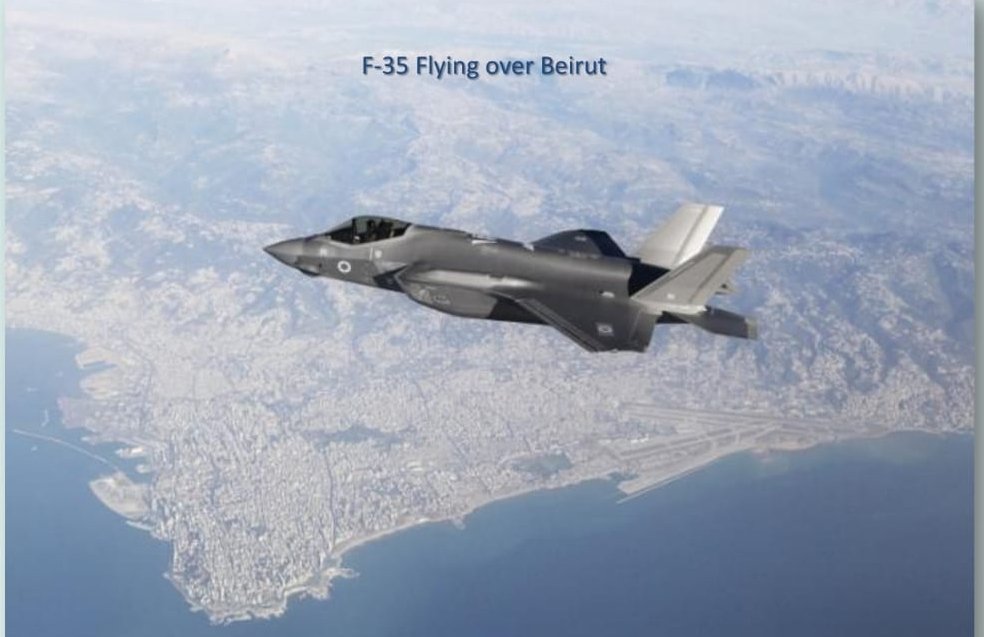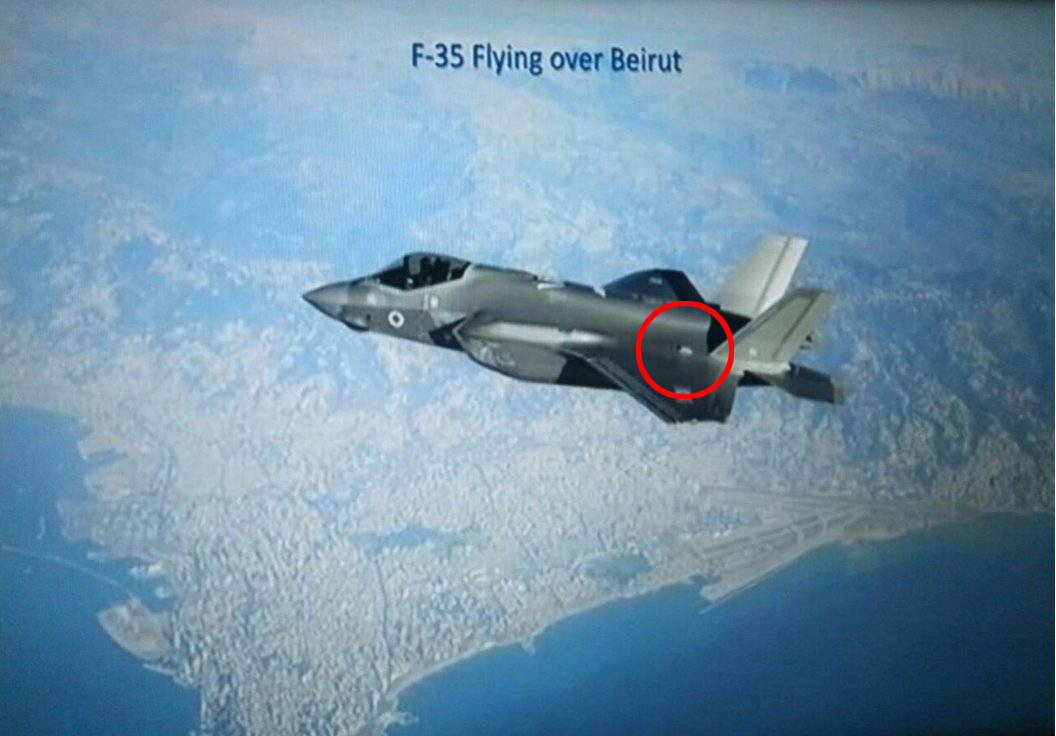A photograph of an Israeli Air Force F-35 flying (more or less..) “over” Beirut has been made public. Interestingly, the image seems to prove the stealthy aircraft was flying with radar reflectors.
As reported yesterday, the Israeli Air Force F-35 stealth aircraft have had their baptism of fire taking part in air strike in the Middle East (Syria and another unspecified “front”) lately. “The Adir planes are already operational and flying in operational missions. We are the first in the world to use the F-35 in operational activity” the Israeli Air Force Commander, Maj. Gen. Amikam Norkin, said during a IAF conference attended by 20 commander of air forces from around the world. Interestingly, Norkin also presented an image showing an IAF F-35I over Beirut, Lebanon that was not released in first place but surfaced on social media on May 23.
Here it is:
הנה הוא מעל ביירות. pic.twitter.com/vOwLpmV
The somehow blurry image is interesting for at least a couple of reasons: first of all, it shows the aircraft flying at high altitude off (rather than “over”) Beirut. Second, it seems to show that the aircraft was also operating with radar reflectors (highlighted in the image below), hence not in “stealthy mode”:
Highlighted in a screenshot from Israel Television News Company one of the F-35’s four radar reflectors.
Here’s what radar reflectors, also known as RCS (Radar Cross Section) enhancers, are as explained in a previous article this Author posted here at The Aviationist earlier this year:
Stealth aircraft, such as the F-22 Raptor or the F-35 Lightning II 5th generation jets are equipped with Luneburg (or Luneberg) lenses: radar reflectors used to make the LO (Low Observable) aircraft (consciously) visible to radars. These devices are installed on the aircraft on the ground are used whenever the aircraft don’t need to evade the radars: during ferry flights when the aircraft use also the transponder in a cooperative way with the ATC (Air Traffic Control) agencies; during training or operative missions that do not require stealthiness; or, more importantly, when the aircraft operate close to the enemy whose ground or flying radars, intelligence gathering sensors.
This is what we explained explaining how the Israeli the heavy presence of Russian radars and ELINT platforms in Syria cause some concern to the Israeli F-35 Adir recently declared IOC:
[…] the Russians are currently able to identify takeoffs from Israeli bases in real-time and might use collected data to “characterize” the F-35’s signature at specific wavelengths as reportedly done with the U.S. F-22s.
In fact, tactical fighter-sized stealth aircraft are built to defeat radar operating at specific frequencies; usually high-frequency bands as C, X, Ku and S band where the radar accuracy is higher (in fact, the higher the frequency, the better is the accuracy of the radar system).
However, once the frequency wavelength exceeds a certain threshold and causes a resonant effect, LO aircraft become increasingly detectable. For instance, ATC radars, that operate at lower-frequency bands are theoretically able to detect a tactical fighter-sized stealth plane whose shape features parts that can cause resonance. Radars that operate at bands below 300 MHz (lower UHF, VHF and HF radars), such as the so-called Over The Horizon (OTH) radars, are believed to be particularly dangerous for stealth planes: although they are not much accurate (because lower frequency implies very large antenna and lower angle accuracy and angle resolution) they can spot stealth planes and be used to guide fighters equipped with IRST towards the direction the LO planes might be.
F-35s deployed abroad usually feature their typical four radar reflectors: to exaggerate their real RCS (Radar Cross Section) and negate the enemy the ability to collect any detail about their LO “signature”. As happened during the short mission to Estonia and then Bulgaria, carried out by the USAF F-35As involved in the type’s first overseas training deployment to Europe or when, on Aug. 30, 2017, four U.S. Marine Corps F-35B Lightning II joined two USAF B-1B Lancers for the JSF’s first show of force against North Korea: the F-35Bs flew with the radar reflectors, a sign they didn’t want their actual radar signature to be exposed to any intelligence gathering sensor in the area
The two radar reflectors installed on the right side of the F-35. The other two are on the other side.
Since they almost always fly with the radar reflectors, photographs of the aircraft without the four notches (two on the upper side and two on the lower side of the fuselage) are particularly interesting: for instance, some shots taken on Jan. 24, 2018 and just released by the U.S. Air Force show F-35As deployed to Kadena AB, Japan, in October as a part of the U.S. Pacific Command’s Theater Security Package program, preparing to launch without their Luneberg reflectors.
According to Nir Dvori, the journalist who first published the image of the stealth aircraft off Beirut seemingly flying with RCS enhancers, “they test [the F-35]in all kind of options. Fly with and without reflectors”. Indeed, the use of RCS enhancers would simply mean that stealthiness was not required for that specific mission during which they preferred to hide the aircraft’s stealth features preventing the enemy to collect data about the aircraft and test their radar hardware against the Lightning II. Moreover, the F-35 appears to be flying off Lebanon, accompanied by another aircraft (the photo ship), possibly another F-35 or a completely different type – even a G550 like those that continuously fly off Lebanon and Syria and are trackable by means of their Mode-S transponders. This means that the photo might well have been taken during a simple “recon” mission rather than a combat one. Meanwhile, according to Haaretz’s Anshel Pfeffer:
Not all the missions that the F-35 has so far carried out needed this [stealth]capability. They took part in an airstrike on a Hamas tunnel on the border of the Gaza Strip. Hamas does not have radar, but F-35s were used on this relatively simple mission as part of the process through which its proves it various capabilities. More complex operations against Iranian and Hezbollah targets north of Israel would have utilized its stealth capabilities and some of these did not necessarily involve the F-35 launching missiles itself.
Therefore, it seems confirmed that:
- Not all F-35 missions required stealth capabilities
- The Adir jets were also used against “easy” targets
- The F-35s have taken part in missions during those the Adir did not drop bombs (therefore, it probably acted as “combat battlefield coordinator,” collecting, managing and distributing intelligence possibly sharing targeting data to older 4th Gen. aircraft).
- The image seems to prove the F-35 have flown at high-altitude off Beirut (someone says it might have been in international airspace, 12 Nautical Miles from the coast, when the shot was taken, but this can’t be verified based on the screenshot only).
Disclaimer: to our knowledge and based on the sources available on the Internet, those four bumps highlighted in the images you can find in this post are indeed radar reflectors. Several magazines and publications also refer to them as RCS enhancers or Luneberg lenses. Still, if we are wrong and these are EW signal emitters as someone claims, please let us know. Furthermore, the top image is a screenshot from a slide presented during a IAF conference not an actual photograph.




